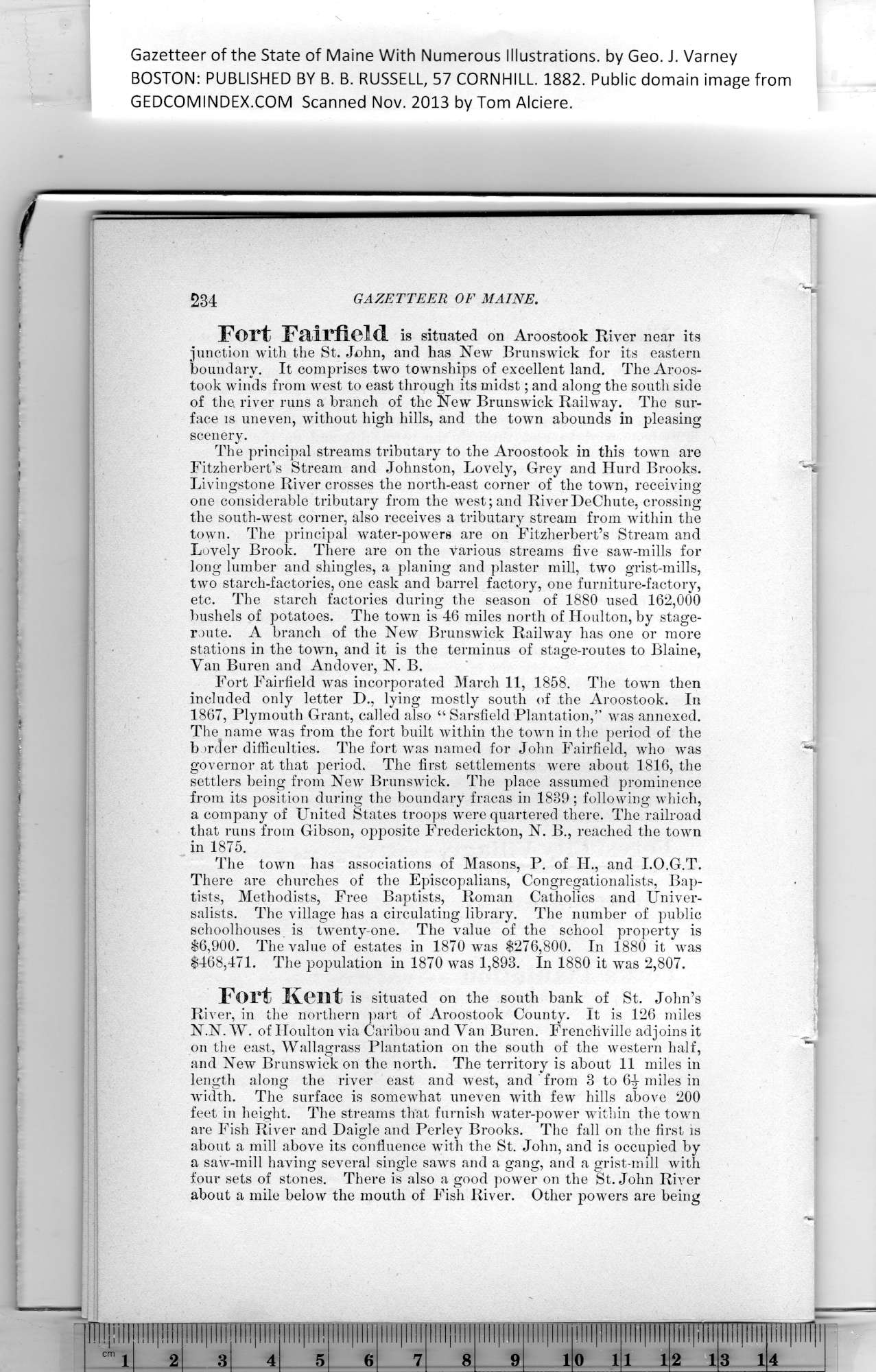|
Gazetteer of the State of Maine With Numerous Illustrations, by Geo. J. Varney
BOSTON: PUBLISHED BY B. B. RUSSELL, 57 CORNHILL. 1882. Public domain image from
234 GAZETTEER OF MAINE.
Fort Fairfield is situated on Aroostook River near its
junction with the St. John, and has New Brunswick for its eastern
boundary. It comprises two townships of excellent land. The Aroos-
took winds from west to east through its midst; and along the south side
of the. river runs a branch of the New Brunswick Railway. The sur-
face is uneven, without high bills, and the town abounds in pleasing
scenery.
The principal streams tributary to the Aroostook in this town are
Fitzherbert’s Stream and Johnston, Lovely, Grey and Hurd Brooks.
Livingstone River crosses the north-east corner of the town, receiving-
one considerable tributary from the west;and RiverDeChute, crossing
the south-west corner, also receives a tributary stream from within the
town. The principal water-powers are on Fitzherbert’s Stream and
Lovely Brook. There are on the various streams five saw-mills for
long lumber and shingles, a planing and plaster mill, two grist-mills,
two starch-factories, one cask and barrel factory, one furniture-factory,
etc. Tbe starch factories during tbe season of 1880 used 162,000
bushels of potatoes. The town is 46 miles north of Houlton, by stage-
route. A branch of the New Brunswick Railway has one or more
stations in the town, and it is the terminus of stage-routes to Blaine,
Van Buren and Andover, N. B.
Fort Fairfield was incorporated March 11, 1858. The town then
included only letter D., lying mostly south of the Aroostook. In
1867, Plymouth Grant, called also “ Sarsfield Plantation,” was annexed.
The name was from the fort built within the town in the period of the
border difficulties. The fort was named for John Fairfield, who was
governor at that period. The first settlements were about 1816, the
settlers being from New Brunswick. The place assumed prominence
from its position during the boundary fracas in 1889; following which,
a company of United States troops were quartered there. The railroad
that runs from Gibson, opposite Frederickton, N. B., reached the town
in 1875.
The town has associations of Masons, P. of H., and I.O.G.T.
There are churches of the Episcopalians, Congregationalists, Bap-
tists, Methodists, Free Baptists, Roman Catholics and Univer-
salists. The village has a circulating library. The number of public
schoolhouses is twenty-one. The value of the school property is
$6,900. The value of estates in 1870 was $276,800. In 1880 it was
$468,471. The population in 1870 was 1,893. In 1880 it was 2,807.
Fort Kent is situated on the south bank of St. John’s
River, in the northern part of Aroostook County. It is 126 miles
N.N. W. of Houlton via Caribou and Van Buren. Frenchville adjoins it
on the east, Wallagrass Plantation on the south of the western half,
and New Brunswick on the north. The territory is about 11 miles in
length along the river east and west, and from 3 to 6|- miles in
width. The surface is somewhat uneven with few hills above 200
feet in height. The streams that furnish water-power within the town
are Fish River and Daigle and Perley Brooks. The fall on the first is
about a mill above its confluence wTith the St. John, and is occupied by
a saw-mill having several single saws and a gang, and a grist-mill with
four sets of stones. There is also a good power on the St.John River
about a mile below the mouth of Fish River. Other powers are being
PREVIOUS PAGE ... NEXT PAGE
This page was written in HTML using a program written in Python 3.2
|
